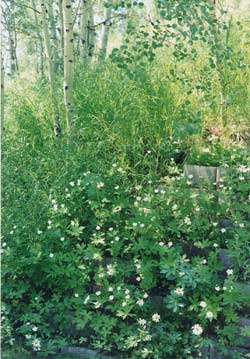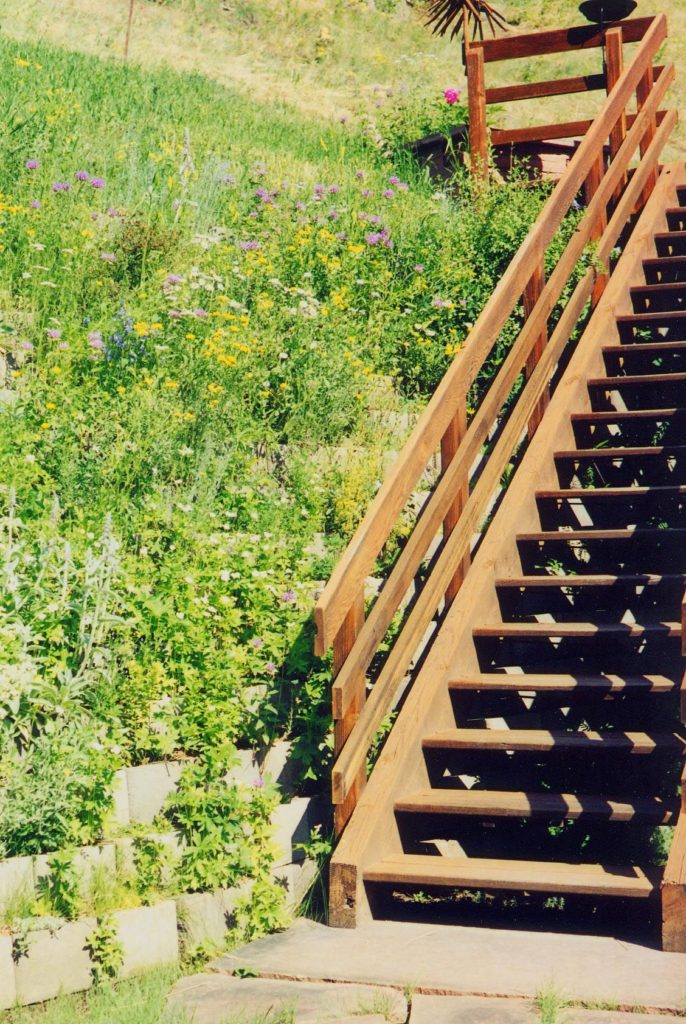Gardening on a Grade: Building a Living Retaining Wall*
by Susan Fernalld, Master Gardener
 In 1990 I built a retaining wall at my home at 8,400 feet in the mountains west of Boulder. It faithfully holds back a steep slope with only earth and plant roots as mortar and it doubles as a flower garden. Following the shape of an east-facing sunny slope for most of its length, the wall curves at one end under a stand of aspen trees, making that portion of it a shady and cooler north-facing retaining wall. In midsummer, the wall garden features sun-lovers like Heterotheca villosa (Golden Aster), Eriogonum umbellatum (Sulphurflower), Erigeron speciosus (Showy Daisy), Campanula rotundifolia (Harebell), Stachys byzantina (Lamb’s Ear), Potentilla gracilis (Cinquefoil), Artemisia ludoviciana and Monarda menthaefolia (Horsemint). The shady portion of the garden features Trollius laxus (Globeflower) and Polemonium caeruleum (Jacob’s Ladder). The only non-natives on the above list are the Lamb’s Ear and the Jacob’s Ladder.
In 1990 I built a retaining wall at my home at 8,400 feet in the mountains west of Boulder. It faithfully holds back a steep slope with only earth and plant roots as mortar and it doubles as a flower garden. Following the shape of an east-facing sunny slope for most of its length, the wall curves at one end under a stand of aspen trees, making that portion of it a shady and cooler north-facing retaining wall. In midsummer, the wall garden features sun-lovers like Heterotheca villosa (Golden Aster), Eriogonum umbellatum (Sulphurflower), Erigeron speciosus (Showy Daisy), Campanula rotundifolia (Harebell), Stachys byzantina (Lamb’s Ear), Potentilla gracilis (Cinquefoil), Artemisia ludoviciana and Monarda menthaefolia (Horsemint). The shady portion of the garden features Trollius laxus (Globeflower) and Polemonium caeruleum (Jacob’s Ladder). The only non-natives on the above list are the Lamb’s Ear and the Jacob’s Ladder.
The retaining wall is made of double bull nose concrete blocks (12” wide, 8” high, and 16” deep). The bottom course of blocks is buried flush with the ground, and each successive course is set half upon the blocks below and half into the hill so that the wall looks like a broad stairway. As I dug into the hillside to make the wall, I quickly transplanted plants taken from the hillside into the earth-filled cavities of the concrete blocks.
 The retaining wall in very easy to maintain. The garden propagates itself by re-seeding or spreading via roots down through the block cavities into the underlying soil. I have incorporated very few non-natives into this zone 3 wall— opting for native plants, with their proven survival skills at high altitude. Other native plants that bloom at other times of the growing season in the wall are Rosa woodsii (Rose), Potentilla fruticosa (Shrubby Cinquefoil), Sphaeralcea coccinea (Scarlet Falsemallow), Aquilegia coerulea (Blue Columbine), Sedum stenopetalum (Stonecrop), Linum lewisii (Blue Flax), Castilleja miniata (Indian Paintbrush), Gaillardia aristata (Blanketflower), Antennaria rosea (Pussytoes), Calochortus nutalli (Sego Lily), Cerastium arvense (Field Chickweed), and Thermopsis montana (False Lupine or Golden Banner).
The retaining wall in very easy to maintain. The garden propagates itself by re-seeding or spreading via roots down through the block cavities into the underlying soil. I have incorporated very few non-natives into this zone 3 wall— opting for native plants, with their proven survival skills at high altitude. Other native plants that bloom at other times of the growing season in the wall are Rosa woodsii (Rose), Potentilla fruticosa (Shrubby Cinquefoil), Sphaeralcea coccinea (Scarlet Falsemallow), Aquilegia coerulea (Blue Columbine), Sedum stenopetalum (Stonecrop), Linum lewisii (Blue Flax), Castilleja miniata (Indian Paintbrush), Gaillardia aristata (Blanketflower), Antennaria rosea (Pussytoes), Calochortus nutalli (Sego Lily), Cerastium arvense (Field Chickweed), and Thermopsis montana (False Lupine or Golden Banner).
* A retaining wall over four feet in height may require a building permit and may need to be designed by a structural engineer.
Search:
Categories
Archives
Additional Resources
Events Calendar
| M | T | W | T | F | S | S |
|---|---|---|---|---|---|---|
| 1 | 2 | |||||
| 3 | 4 | 5 | 6 | 7 | 8 | 9 |
| 10 | 11 | 12 | 13 | 14 | 15 | 16 |
| 17 | 18 | 19 | 20 | 21 | 22 | 23 |
| 24 | 25 | 26 | 27 | 28 | 29 | 30 |
| 31 | ||||||


